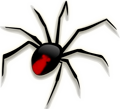Money Spider
Various
 NEW There's an alternative version of this page at the new website www.ark.au/money-spider.html NEW There's an alternative version of this page at the new website www.ark.au/money-spider.html Other Names: Sheet-web Spiders, Sheet weavers.
Family: Linyphiidae (Money Spiders). 34 species known in Australia, 200 species estimated. 4,400 species in the world. Many of the currently known Australian species were introduced by humans.
Size: Body 1-6 mm
Distribution: Occur over most or perhaps all of Australia. A few species only live in caves.
Habitat:
References: Whyte and Anderson. Framenau, Baehr & Zborowski. Wikipedia
About the Money SpiderWhyte and Anderson say that "This family is one of the great unexpolred frontiers in Australian arachnology". They have 8 eyes in two rows and long slender legs. They make small sheet-webs with a raised peak or dome in the middle. The spider rests upside-down inside the dome. These spiders are most often seen because of their webs, especially in the early morning when there is dew on themand there may be hundreds of the tiny webs in a meadow. Spiders in this family are commonly known as money spiders in Australia, New Zealand, the United Kingdom, Ireland, and in Portugal, from the superstition that if such a spider is seen running on you, it has come to spin you new clothes, meaning financial good fortune.
Note that dead spiders usually fade in colour, so nearly all the spiders will look blacker or darker in colour in real life than they do in the photos of dead spiders from the museum. 
Photo taken at Australian Museum, Sydney.
Recommended Reading
|
 A Guide to the Spiders of Australia, by Volker W. Framenau, Barbara C. Baehr, and Paul Zborowski.
A Guide to the Spiders of Australia, by Volker W. Framenau, Barbara C. Baehr, and Paul Zborowski. This is a great field guide to Australian spiders. It's a toss up between this one and Spiderwatch for my second favourite spider field guide. This one is a lot different to Spiderwatch. It's got more than twice the number of pages. It's got much better photos. It comes with a soft clear plastic cover protecting the usual soft cover. On the other side of the argument, it's got no index other than an index of family names (i.e. no index of actual spider names, not their common names and not their scientific names). Which makes it hard to find things in it, if you don't know what family they are in. Also it's based on families and not individual spider species. It's still a wonderful book though. From the publisher, "This definitive guide to the subject, written by three experts in the field, offers a window into a fascinating world. Notorious species such as the Redback and the Sydney Funnel-web sit alongside less wellknown but equally intriguing spiders such as the ant-mimics and net-casting spiders. The introduction covers spider structure, evolution, reproduction, silk and venom, together with peculiarities of the family within an Australian context.
The two main sections of the book deal with Trapdoor Spiders and Modern Spiders, and within each section there is a chapter on each of the 80 or so spider families that occur in Australia. Each is illustrated with beautiful photographs of the subjects, with more than 30 images per family for some of the larger groups such as the jumping spiders, and many rare images never before published. "
Purchase from Amazon.com.au (Australian Site)
| See Also
Australian Mammals
Australian Birds
Australian Reptiles
Australian Frogs
Australian Fish
Australian Wild Plant Foods
Return to Australian Spiders
Return to Site Map
Share This Page
australian family species spider spiders
Content is copyright © Survival.ark.au 2005-2025 All Rights Reserved. Terms of Use. Definitely read the disclaimer before trying anything from this website, especially including the practices and skills. This website uses affiliate links – this doesn't cost you any more, but I get a commission on purchases made through the website. As an Amazon Associate I earn similarly from qualifying purchases.
|



